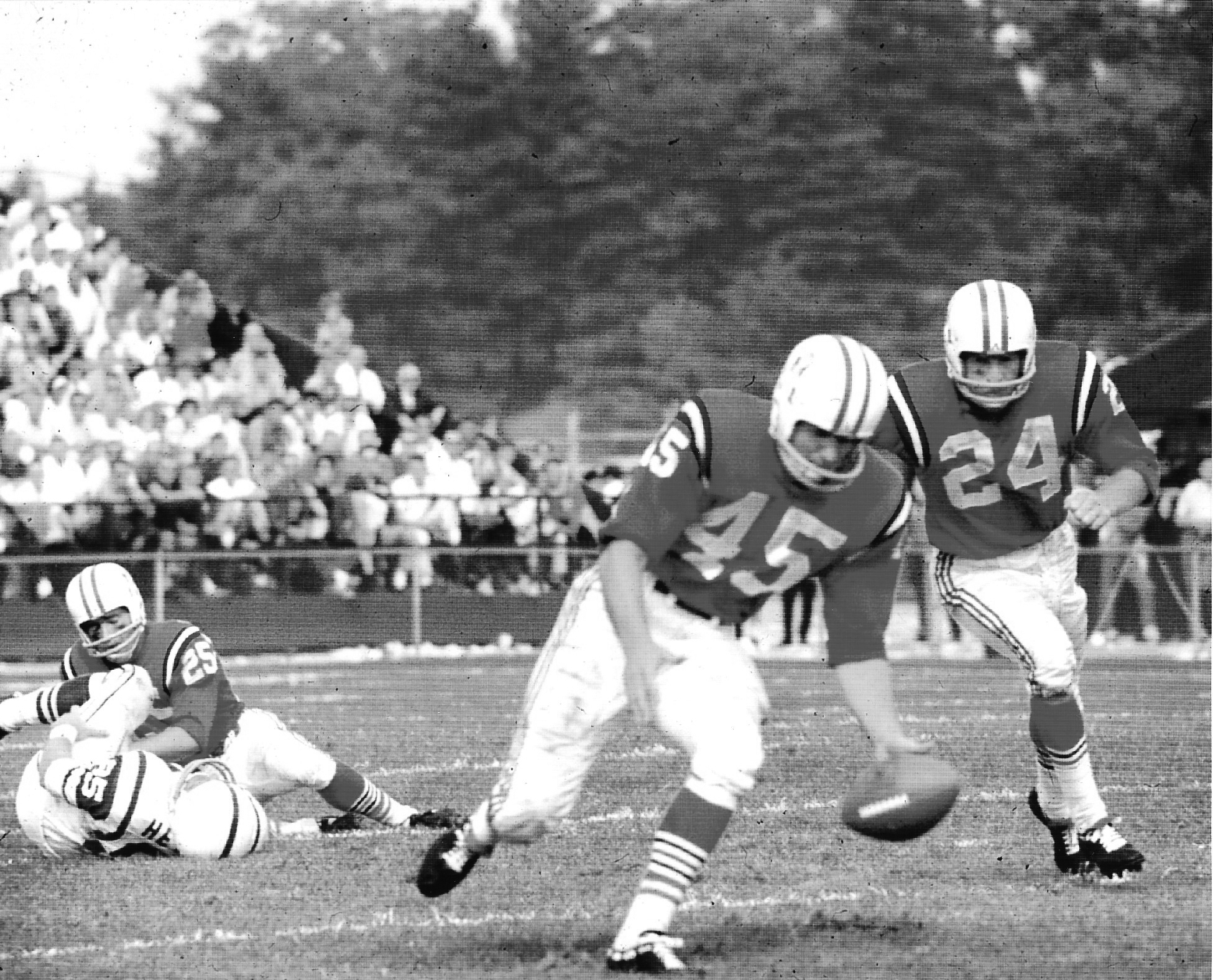Tom Stephens (#45) played five seasons with the Boston Patriot franchise, New England’s first professional football team.
By RICH FAHEY
They were a band of brothers, the men who first brought professional football to New England in 1960.
The Boston Patriot franchise in the American Football League was worth $250,000 that year and is now the NFL’s New England Patriots and worth $3.4 billion, according to Forbes Magazine.
Tom Stephens, 81, was a member of that team. He and his wife, Lonnie, have lived in Swampscott for more than 40 years, now splitting time between Swampscott and Naples, Fla.

Stephens, who had an accomplished career as a player, coach and athletic director, also happens to be the answer to an excellent trivia question: Who wore the No. 44 at Syracuse University between Pro Football Hall of Famer Jim Brown and the late Ernie Davis, the first African-American to win the Heisman Trophy and a member of the College Football Hall of Fame?
The answer, of course, was Stephens, who played for the Orange between 1956-58.
On. Nov. 12, 2005, Stephens participated in a ceremony at Syracuse where the school officially retired the number 44, which was also worn by Floyd Little, a member of the Pro Football Hall of Fame, and North Andover’s Rob Konrad of St. John’s Prep.
He still keeps in touch with some of his former Patriot teammates, such as Tom Yewcic, who holds a charity golf tournament each year, which includes both alumni such as Patriot Hall of Famer Gino Cappelletti and Len St. Jean and present players. He also remains active with the New England Patriots Alumni Club.

The smooth-running franchise known for its consistent excellence and four Super Bowl trophies bears little resemblance to the franchise’s chaotic existence in its early years, when the team shuffled around venues all around Boston until finally moving to Foxboro in 1971. The Patriots of that time were wanderers, playing their home games at BU’s Nickerson Field, Harvard Stadium, Fenway Park and BC’s Alumni Stadium.
Stephens actually began his pro career in Baltimore, after being drafted by the Baltimore Colts in the 11th round of the 1959 NFL draft. Stephens found himself as a defensive back trying to a crack a team that had just won the NFL championship the year before, and he was cut.

He was then drafted into the Army and spent time at Fort Benning, Ga. As he was leaving the Army in June 1960, he got a call from Patriot coach Mike Holovak, asking if he wanted to try out for the new Boston franchise in the AFL.
Some 120 players came through that first camp at UMass Amherst, and Stephens recalls players coming and going at a dizzying rate.
“You’d thought you made the squad and then — boom — they’d bring two new players in and you didn’t know where you stood.”
He played five seasons with the Pats, mostly as a 6-2 tight end who played at about 215 pounds — about the size of a cornerback or halfback now.
In 1962, he was injured when a lineman tackled him in the middle of his back and broke two bones. He was only out for four games, but in the spirit of the AFL of those times, he picked up a second job.
“They asked me to help out Gerry Moore in the publicity office and make some public appearances for the team, to the Lions Club and the like,” he said. “They told me I was pretty good at it.”
With the 33-man rosters in the early days of the AFL, you had to do a lot more than just play a position. Stephens could play both offense and defense, and spent time as a split end, tight end, flanker, defensive back and safety and was told to learn the running plays one year. He was also the back-up punter and played on all the special teams. And, he returned punts and kickoffs. The versatility had its rewards.
“That probably kept me around for a couple of more seasons,” he said.

Through five seasons, he caught 41 passes for 506 yards and five touchdowns, returned five kickoffs for 57 yards and returned 19 punts for 151 yards. One of his treasured possessions is a game ball from the 1961 season.
He never made more than $10,000 in a year while playing for the Pats, but at the time, he noted, teachers only made $3,000 a year and he and wife bought their first house for $16,000.
In 1965, Holovak realized that Stephens wasn’t going to make the team — Tony Romeo, a bigger tight end and Jim Whalen had come along. He told Stephens he had secured him a job in the recreation department in the town of Belmont.
In 1965, Holovak realized that Stephens wasn’t going to make the team — Tony Romeo, a bigger tight end and Jim Whalen had come along. He told Stephens he had secured him a job in the recreation department in the town of Belmont.
Stephens began his coaching career at Curry College soon afterwards, spent three years coaching at Harvard under John Yovicsin, including the famous 29-29 “win” over Yale, and then headed back to Curry, where he coached football and was the athletic director for 23 years. In 1995, he was named to the Curry College Athletic Hall of Fame.
Stephens was born in Galveston, Texas but moved to New York when he was 15 and played most of his high school years at Washington High School in Mohawk, N.Y., where he met a cheerleader named Lonnie, his wife of 57 years.
For his senior year, he took a different tack that helped him get noticed. He had read about “Football Town, U.S.A.” in “Look” magazine. His mother moved with him to Massillon, Ohio, home of the famed Massillon High football program, where he played his senior year.
When Stephens won a scholarship to Syracuse, Lonnie joined him there and cheered him on. He played in two bowl games in three years and, as a sophomore, backed up Pro Football Hall of Famer Jim Brown when Brown was a senior.
“I’d say he was the best of all time,” said Stephens. “He was 6-2, 230, and he could run you and then away from you.”
Stephens was an All-East selection his senior year. For his three-year career at Syracuse, he had 148 rushes for 657 yards and nine touchdowns and caught 26 passes for 284 yards and four more scores. In 1957, Stephens led SU with seven touchdowns.
After Stephens made the Patriots, the couple lived in Nahant for years before moving to Swampscott, where they have lived for more than 40 years and raised two children who both excelled in sports at Swampscott High: daughter Lynda, a decorative painter and musician, and son Thomas, a lieutenant on the Swampscott police force who starred in several sports at Swampscott High and also earned his own football scholarship to Syracuse.

Tom and Lonnie now spend five months a year in Swampscott and seven months at their home in Naples, Fla.
Stephens said he doesn’t begrudge any of today’s players their fame and fortune. He is grateful that he left the game with his health intact, still enjoys golf and remains active. He realizes that the size and speed of today’s players takes its toll health-wise and the average NFL career is short.
He has no regrets about missing the big money or the Super Bowls. “It was a different time and place,” he said.
Photos: Courtesy of Tom Stephens

